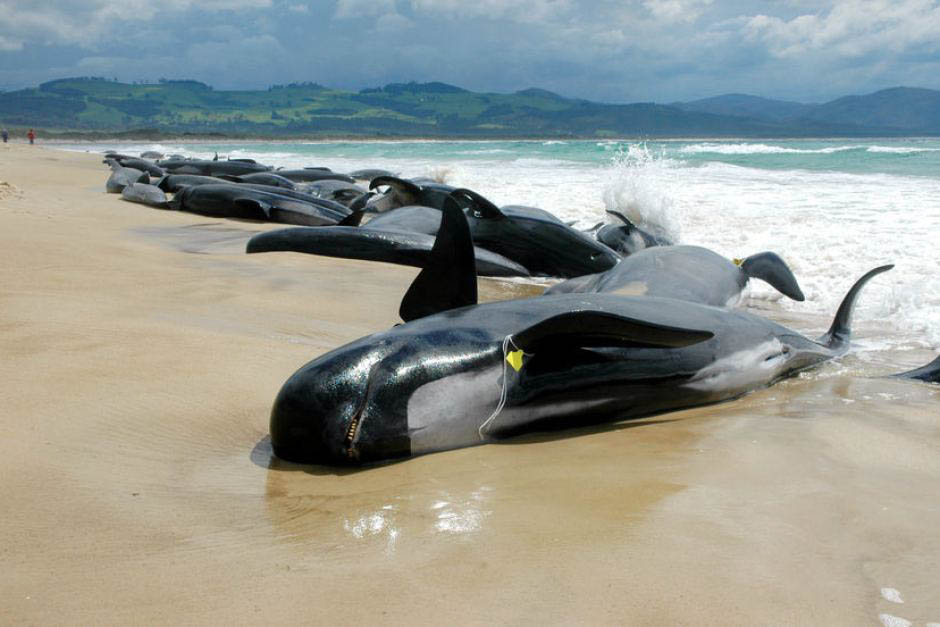The simplest solution to explain mass strandings would be that pods of whales beach because they are lost. No scientist has ever advanced such a simple idea or proven it otherwise. Does it make you wonder why?
If you want to see what causes whales to strand, do not look in the sand. Instead, look at the rough waves washing ashore and consider the effects of pressure and seismic activity.
Diving whales, human divers, frogs, birds, otters, sea turtles, manatees, polar bears, seals, walrus, and fish with air-filled swim bladders all face the same danger. They are all divers and must never forget that the air contained in their internal air spaces must be balanced with the external pressure at the depth of their dive. A diver’s body can only function normally when the forces acting inside and the forces acting outside are nearly equal. Every diver must constantly equalize pressure as the depth of their dive changes.
Pressure, whether due to the weight of the atmosphere plus the water, or caused by exposure to low-frequency sonar waves, explosions, or seismic p-waves generated during natural seafloor upheavals, must always be equalized. Said differently, if rapid changes in the surrounding water pressures suddenly exceed the diver’s ability to counterbalance, internal barotraumatic injuries in the cranial air spaces cannot be avoided. To avoid injury, pressure differences must be constantly near equal.
The average frequency of seismic p-waves given off by an underwater earthquake is 7 cycles per second. These are compressional waves identical to US Navy sonar waves. Each cycle has a positive pressure phase followed a split second later by a negative pressure phase. This means that exposure to the average underwater seismic p-waves will cause the volume of entrapped cranial air to increase and decrease 14 times per second. Sonar waves are much higher in frequency.
Imagine the volume of air in your sinuses and your middle ear air cavities bouncing up and down by 100% at a rate of 14 times every second!
When any underwater diver’s ability to compensate cannot cope with either the speed or the intensity of the pressure fluctuations, the air spaces will suffer a pressure-related rupture call barotrauma. This is the most common injury in all divers including fish, fowl, reptiles and mammals and is every diver’s weak spot.
An average of 1,500 undersea earthquakes greater than magnitude 5 occur annually along subduction zones near continents and islands and along the mid-ocean ridges that circle the globe like seams on a baseball. These seismic danger zones are where lots of squid and fish hangout — the whales simply follow their food into harm’s way.
One more important piece of the puzzle must be added. Ninety percent of the above-mentioned tectonic borders course along the bottom of our oceans and seas. This means that 90% of all the seismic upheavals happen underwater near where whales and dolphins dive to feed as many as 3-4 times a day.
The feeding grounds of whales and dolphins is not such a safe place to dive, especially when you realize that during a natural undersea upheaval, the rocky bottom jerks about, pushing and pulling the water column, generating rapid and excessive changes in ambient water pressures. Such oscillations in pressure can easily traumatize the cranial air sinuses of an entire pod of diving whales all at the same time. If excessive, the membranes tear and the loose air leaks into their heads. In other words, busted sinuses cause whales to lose their ability to echo-navigate and echolocate their food. Nor can they dive deeper than a few feet due to severe sinus pain. One seaquake might even cause two or even three pods of pelagic odontoceti to mass beach.
But why is it always a beach?
Because the shoreward flow of the current guiding the whales is the same energy that carries each grain of sand to build the beach in the first place. Where there is no beach, there is no shoreward flow to carry the sand or the whales. However, there is one exception. When a big storm nears a rocky shoreline, it is possible that whales can be shoved into the rocks by the strong current running ashore.
Why don’t the whales swim away from the beach and not get stuck?
The answer is simple. All mass stranded whales and dolphins have lost their acoustic sense of direction. They are like a blindfolded swimming team thrown overboard 50 miles offshore. They come ashore only when and where the tide and the wind-driven currents guide them. Any lost swimmer at sea, dead or alive, can only swim or drift downstream with the current simply because downstream is the path of least drag. Said differently, a sense of direction in absolutely mandatory to fight the current and swim upstream.
This understanding also explains why beached whales and dolphins never have any fresh food in their stomachs and are severely dehydrated (all their fresh water comes from the food they eat). They have been lost at sea without being able to dive and feed, so naturally they have only non-digestible squid beaks and hard scale of fish eyes in their stomachs.







